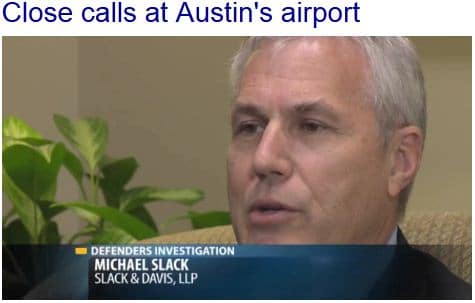Close Calls at Austin’s Airport
Michael Slack is featured in this KVUE (ABC) news story about Austin’s airport, air space and this weekend’s Formula 1 race. Technology, he says, contributes to the problem of near mid-air collisions. “Some pilots are flying around in aircraft that are really not suitable to be flown in high-traffic areas,” argued Slack.
——
Close Calls at Austin’s Airport
by Andy Pierrotti, KVUE News (with photojournalist Erin Coker)
Posted on November 15, 2012
A KVUE Defenders investigation has discovered reports of planes flying in Austin skies involved in what some consider near-disasters. It’s likely some passengers never knew it ever happened. Defender Andy Pierrotti dug through hundreds of complaints made by Austin pilots and air traffic controllers to find the information.
 The reports come from complaints filed with NASA’s Aviation Safety Reporting System. It’s a voluntary system that allows pilots and air traffic controllers to report anonymously when they witness something they consider dangerous.
The reports come from complaints filed with NASA’s Aviation Safety Reporting System. It’s a voluntary system that allows pilots and air traffic controllers to report anonymously when they witness something they consider dangerous.
Since 2005, 41 complaints were filed involving Austin’s airport. Four of those involved claims of near mid-air collisions.
One air traffic controller wrote in a report, “Why are we allowing the FAA to play Russian roulette with aircraft full of passengers?”
Another controller complained to NASA about the failure to enforce plane separation rules writing, “We use it incorrectly, inappropriately, and we are going to kill someone.”
“A lot of these write-ups seem to suggest, occasionally, the procedures and techniques that they have in place to keep aircraft safety separated aren’t always followed exactly as they should be,” said Sean Reilly, a long-time Austin pilot with Paradigm Jet Management, who reviewed the reports for KVUE.
One of the complaints about a near mid-air collision involved a commercial airliner and a small turbo prop plane.
According to the report, a controller instructed the smaller plan to prepare to land, while a commercial plane was taking off. The controller says both were “wired on intersecting courses” at about 6,000 feet in the air. Both pilots took evasive action to avoid a catastrophe, passing within just a few football fields away.
To put that in perspective, that gives pilots little time to react — even if a mile apart. “If they are head-on, at which aircraft are allowed to fly, that altitude, a mile is going to go by in about five seconds,” says Reilly.
It’s a claim involving a serious breach of safety but unreported by the Federal Aviation Agency.
The FAA responded to these concerns in an email, telling the Defenders the reports we found “are among the many tools the FAA uses to monitor safety…We look into these anecdotal reports and use radar data and other tools to obtain an exact measurement of separation between aircraft.”
The FAA regulates air travel and is the primary source of documenting problems.
According to the agency, there were 35 operational errors, or confirmed cases within Austin-Bergstrom International Airport’s air space when planes got too close from 2009 to last year. The FAA contends none were considered dangerous or near mid-air collisions.
“Technology is needed to help this problem,” explained attorney Michael Slack, a pilot who specializes in aviation litigation.
He argues there are too many smaller aircraft with antiquated communications equipment sharing the skies with commercial airliners. “Some pilots are flying around in aircraft that are really not suitable to be flown in high-traffic areas,” argued Slack.
There’s another issue. This weekend’s Formula 1 race is expected to bring in an influx of aircraft. There are already 130 private planes reserved to fly into the airport, and that doesn’t include 40 helicopters sharing the skies too.
“It will be a challenge to see if our airport that’s been trying to evolve into an international airport – boom — the weekend of November 18, it will become an international airport whether it likes it or not,” Slack said.
Austin’s airport is growing. When it opened in 1999, 7.6 million passengers passed through its terminals. In 2011, more than nine million did.
“It’s just more airplanes taking up a limited amount of space is basically the fundamental problem,” contended Slack.
The FAA maintains that it “has taken an aggressive approach to safety improvements” over the past several years “…including “new management, updated safety equipment and improved procedures.”
